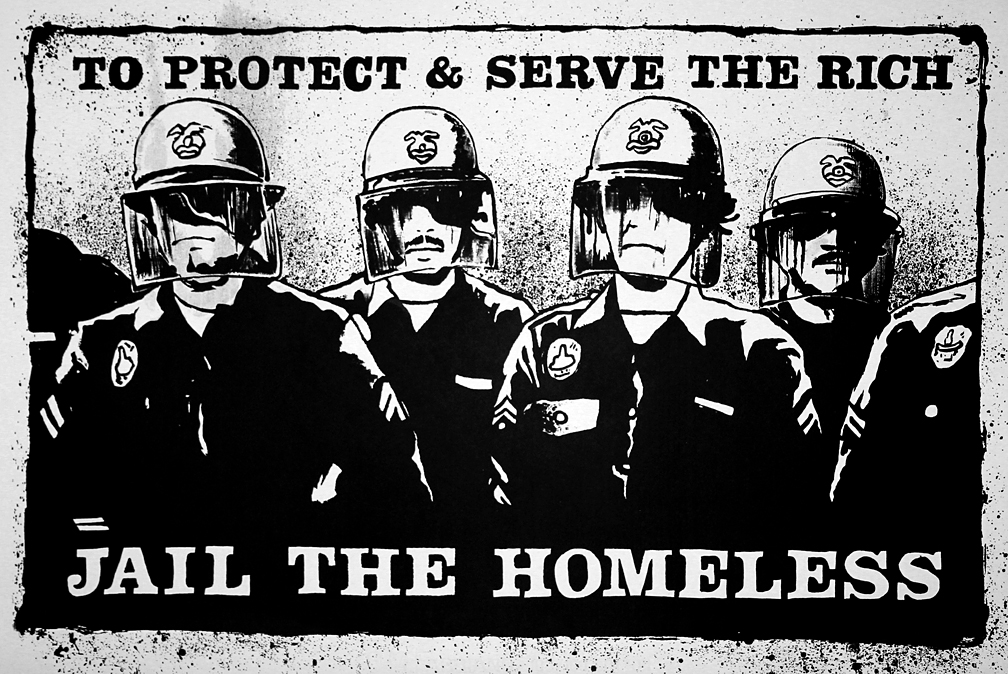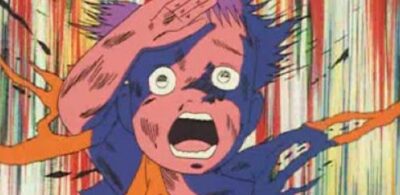PRISON NATION
I am pleased to announce that a silkscreen poster I created in 1987, To Protect and Serve the Rich – Jail the Homeless, is part of the exhibit, Prison Nation: Posters On The Prison Industrial Complex, held at the UC Merced Kolligian Library at the University of California, Merced. The show travels to five other venues in California’s San Joaquin Valley and Inland Empire areas over the course of the next two years.

My own contribution to the exhibit, To Protect and Serve the Rich – Jail the Homeless, does of course have a unique anecdote behind it, as the print was inspired by real world events. In the year 1987 I lived and worked in a ramshackle artist’s loft located in downtown Los Angeles, twelve years before gentrification sent prices in the decaying and abandoned neighborhood through the rooftop around 1999.
The old industrial area where my studio was found sat at the edge of L.A.’s historic Little Tokyo district, and the pre-earthquake-code red brick building that housed my second-story rented loft was constructed in 1911. The Skid Row area of L.A. was a stones throw from my studio, and the entire disintegrating zone was a magnet for the thousands of homeless people who slept on the street in every available doorway. At the time it was estimated that around 30,000 people were homeless in Los Angeles, and that some 10,000 of them slept on downtown streets.
The area was a distribution point for imported goods that came from the port city of San Pedro, and every day trucks brought millions of crates full of cheap merchandise to the small businesses operating in the Toy Town and Fashion districts. The discarded cardboard boxes became building material for throngs of the homeless, who carried off huge slats of the cast off cartons on their backs. In my neighborhood so many destitute people constructed makeshift huts of cardboard on the sidewalks that small shantytowns were formed, and the shelters in that wretched urban community were called “Cardboard Condos.”
Everyday from my studio window I witnessed a parade of poverty-stricken and disfavored humanity. Some were clearly insane, others alcoholics, but there were also many unemployed workers and war veterans who were reduced to living on the streets. On occasion I would see a pitiable family on a grimy avenue pushing a grocery cart filled with all their worldly possessions.
Flop houses were so overcrowded, or filthy and infested with rats and roaches, that poor folks preferred living on the sidewalks. I once talked with a grizzled Vietnam war vet living on the street who told me that as long as he could wrap himself up in enough layers of newspaper at night, he could survive the cold. I suppose that was the proper usage for the city’s bourgeois “newspapers,” but others living on the street were not so resilient. Hypothermia plagued untold numbers of those I have so far described… it continues to do so.

When I lived in my downtown seventh heaven Tom Bradley (1917-1998) was the Mayor of LA and Daryl F. Gates (1926-2010) was Chief of the Los Angeles Police Department. Complaints from downtown business interests convinced Bradley to take action against the homeless; Bradley and Gates agreed to physically remove the down-and-out population from the city center of L.A.
On May 28, 1987, Police Chief Gates announced at a press conference that the “so-called homeless” were being given seven days to break their camps and disperse, those who did not comply would have their properties seized and be subject to arrest. Gates said he instructed his officers to post 50 notices on streets where the homeless gathered, of course, the official broadsides appeared in my scenic neighborhood.
With nowhere else to go, many of the homeless disregarded orders to abandon their rudimentary cardboard lodgings, they vowed to resist. On the morning of June 4, the day of the looming police action, Mayor Bradley belatedly offered the homeless a forlorn empty lot as a short-term “campground,” but the site would not be available until a week after the raid. There were no takers. Finally, as late afternoon came to my beloved City of the Angels, the LAPD rolled into action against the homeless.

The sky was overcast, heightening the yellow “Police Line Do Not Cross” tape that seemed to be everywhere in the sector; red and blue rooftop lights flashed from dozens of LAPD squad cars cordoning off the streets; groups of uniformed and helmeted officers moved from one cardboard hut to the next, rousting occupants, sending them on their way or arresting them; black and white LAPD buses were filled with detainees; ubiquitous LAPD helicopters swarmed the sullen skies. The police methodically razed hundreds of homeless shelters, confiscating or trashing the meager belongings that were found within.
I am positive director John Carpenter witnessed or knew of the June 4th raids on the camps of L.A.’s homeless, since a precise sequence from his subversive 1988 science fiction classic They Live, mirrored the ’87 police operations, though in a tremendously exaggerated and violent fashion (you can see this 22 minutes into his film). That the scene I refer to in Carpenter’s movie was shot on the streets near my downtown L.A. neighborhood, only buttresses my opinion.
The June 4th raids provided an ominous and unsettling scene, and after snapping a few photographs I began to get the vibe that the boys in blue did not appreciate my playing paparazzi. As there was no one around save for the homeless and the police, this bohemian artist made a beeline to his shoddy yet safe garret. It was then and there that I began creating my Jail the Homeless silkscreen print as an immediate response.
My black and white print depicted a line of faceless LAPD officers, with the work’s title integrated into the stark design; the image was inspired by the lines of police I saw during the raids on the homeless camps. To create the poster I quickly drew my image directly on the stretched silk screen, and from there I printed my edition of posters using oil based paint. The next day I went about disseminating the contentious print in my neighborhood, which included giving away copies to the many stressed-out homeless folks in my area.
Prison Nation runs from Jan. 19 to March 9, 2013 at the UC Merced Kolligian Library.


